Land Rover fans can enjoy new Discovery
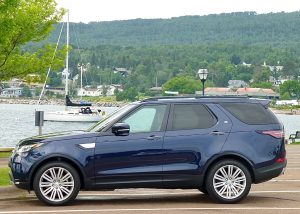
Land Rover’s 2018 Discovery HSE visited Grand Marais, Minnesota, powered by a smooth, silent 3.0 V6 turbocharged diesel with 443 foot-pounds of torque.
By John Gilbert
Land Rover has built all manner of luxury off-road vehicles for decades, and the company’s recent success has allowed it to establish a full-range of vehicles — all of them tough, over-achievers, all of them expensive, but filling every niche SUV buyers might be looking for.
If I had to pick one, it would be tough. There is no such thing as a Land Rover that is not enjoyable to drive or to ride in. I might take the new Velar, for its sleek styling that is remindful of the Evoque, which is low-slung and sporty.
My latest attraction, however, is the Land Rover Discovery, and it is a mind-blower for all sorts of impressive reasons. It was brought back into the U.S. market a year ago as a replacement for the LR4, the recently discontinued base entry. The Discovery no longer is the basic, bargain-priced Land Rover.
I actually drove the Discovery a couple of times before I checked out the fact sheet and learned it was a turbo-diesel. It was so quiet as to be nearly silent, but its power came on with a steady rush. Shifting was smooth all the way up, and the suspension settings kept it poised and firm in any and all cornering ventures. We drove from Duluth to Grand Marais and back one afternoon, with two adults comfortably in the rear seats.
We arrived for the Grand Marais Art Festival, and were happy to find out that Sven and Ole’s Pizza is back to its traditional old form — try the Meatzza Pizza — and walking around town and hiking along the breakwater is a treat any time. We listened to a Twins game on satellite radio, and the only complaint I noted was the lack of a CD player. Before I could complain, my wife, Joan, found a CD player fixed inside the glove compartment.
We didn’t try the cozy confines of the third-row seats, and with that row folded into the carpeted floor, nobody would guess there was a third-row.
You could spend up to $200,000 for a Land Rover Range Rover, the flagship of the line, or as little as $40,000 for the base Discovery Sport — if you stay out of the option bin. Other models range up and down the scale in between, including the Velar, Range Rover Sport, and Evoque.
The Land Rover Discovery I test drove came equipped with Land Rover’s own specific 3.0-liter V6, but not just a V6. This is the highly refined V6 turbo-diesel out of the highest-buck Range Rover, with 254 horsepower and — get this — 443 foot-pounds of stump-pulling torque. With exhaust cleansed by a urea filter, it goes like a race-bred vehicle, through an 8-speed automatic transmission, and you can get it up and over 400 miles of range, easily topping its EPA estimated 26 miles per gallon in highway driving.
It has earned its base price of $67,490, and even its loaded sticker, after liberal doses of options pushed it up to $81,395.
Now, a decade or so ago, that would have seemed outrageously high and make the vehicle unrecommendable. But along with the proliferation of SUVs to dominate the marketplace, skyrocketing prices have risen faster than the popularity of the SUVs. So now it is not uncommon to see a loaded and large SUV for $80,000 or $95,000. And stickers on loaded luxurious pickups are not far behind.
So if we can agree that it’s possible for a do-everything vehicle that is strong, safe, and over-engineered in every respect to be worth such a lofty price tag, then it’s just a matter of choosing which features you value most, or which ones surprised you the most.
To start with, you are looking through a heated windshield at your heads-up display, and on down the road ahead, which is lighted brilliantly by LED headlights. You are sitting comfortably in your Windsor leather buckets, which are heated and cooled and have a massage feature to keep you alert. You’ve set the cruise control to its adaptive setting, choosing which following interval you want, and the device also has a speed limiter, and the ability to read road signs and relay the information.
Always at the forefront of structural strength and safety, the Discovery takes it to the high levels all Land Rovers boast. Electronic power steering, electronic air suspension, plus a twin transfer case for serious off-roading with the all-wheel drive, the off-roading is enhanced with active rear lock. A terrain response switch is a round knob on the center console, far enough back so you won’t risk confusing it with the gear shifter. The shifter and the terrain response gizmo are operated by round, puck-shaped switches. When you start the car, the larger shift puck rises out of the console, affording you the choices of drive, neutral or reverse. The terrain-response knob can be set to normal for highway use, or any and all terrain conditions, including sand, snow, off-road or rock climbing.
There also is dynamic stability control, to keep you on the straight and narrow. Literally. Lane keep assist, blind spot assist, plus brake force assist, and the 360-degree view to make sure nothing is in your way all come with standard or option packages. My wife, Joan, has a favorite gadget and it is automatic high-beams that come on and dim quicker than you could do it manually as a car approaches.
The test vehicle also has automatically dimming exterior mirrors for the driver’s vigilance. All the latest connectivity elements are there, too, of course. In reality, the Discovery has been put to the limits to make the passenger experience as pleasant as the driving experience, which is saying something.
Dealerships are comparatively scarce for Land Rover. A buyer in Duluth, for example, would have to go to the Twin Cities to find a Land Rover and/or Jaguar dealership. It does seem that dealer visits might be less important for such a rugged vehicle, and that is healthy — to see such a rugged group of vehicles regain their status after some shaky times a decade or so ago.
That’s when Ford cut adrift both Jaguar and Land Rover and the British cousins had to fend for themselves, hoping to find a qualified owner. It came from India, where Tata Motors came through with the money required for both Jaguar and Land Rover to go onward and upward in quality and quantity. Both have sophisticated designs, and both have engines that surprise even hot-car fans.
Long before the SUV craze engulfed the United States, there was Land Rover. The British company made SUVs capable of negotiating off-road treks and treacherous terrain of all kinds, and it did it with an aplomb that confounded competitors and critics alike.
The U.S. had its Jeeps, with their all-out, off-road toughness, and GM’s Suburban, which predated the SUV craze, endured as a rugged family truckster. But Land Rover built vehicles to conquer any challenge in any weather, and yet still be capable of taking the Lord and Lady of the Manor to the ball that evening with grace and class.
When I first drove Land Rovers, they were powered by the little lightweight Buick V6 that had pretty good power, but certainly seemed beneath the stdately dignity of the company. On that venture, I got the chance to view a cutaway of the chassis, and noticed that where a “normal” vehicle might have frame rails, Land Rovers had something approaching girders. I mean, heavy-duty construction style steel bars that could obviously take a beating.
My impression was that a Land Rover is the type of vehicle you would choose if you were assigned to drive from here to Hudson Bay, without using any roads.
Flashing forward, I have been able to take part in Land Rover off-road challenges in Canada, on the West Coast, tracing the Continental Divide along the top of the Rocky Mountains, and over all types of terrain in Iceland. Rejuvenated when they might have been destined for extinction, Land Rover is ready and willing to show off its quality and toughness for the world to see.
And it is simply up to any customers who want luxury with their capable off-roading to find a dealership and make their own Discovery.


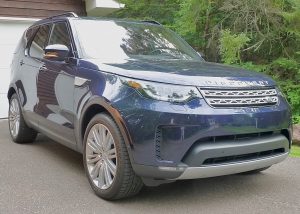
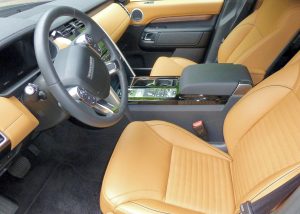
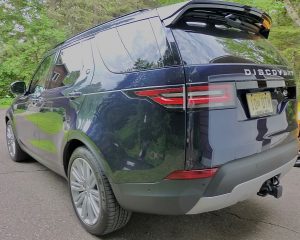
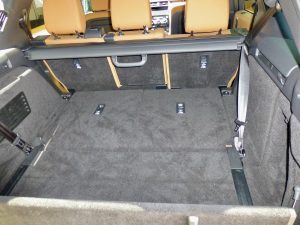
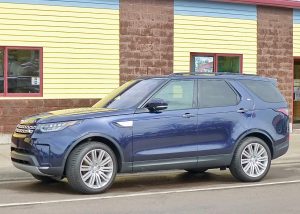
 John Gilbert is a lifetime Minnesotan and career journalist, specializing in cars and sports during and since spending 30 years at the Minneapolis Tribune, now the Star Tribune. More recently, he has continued translating the high-tech world of autos and sharing his passionate insights as a freelance writer/photographer/broadcaster. A member of the prestigious North American Car and Truck of the Year jury since 1993. John can be heard Monday-Friday from 9-11am on 610 KDAL(www.kdal610.com) on the "John Gilbert Show," and writes a column in the Duluth Reader.
John Gilbert is a lifetime Minnesotan and career journalist, specializing in cars and sports during and since spending 30 years at the Minneapolis Tribune, now the Star Tribune. More recently, he has continued translating the high-tech world of autos and sharing his passionate insights as a freelance writer/photographer/broadcaster. A member of the prestigious North American Car and Truck of the Year jury since 1993. John can be heard Monday-Friday from 9-11am on 610 KDAL(www.kdal610.com) on the "John Gilbert Show," and writes a column in the Duluth Reader.